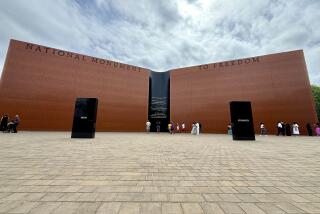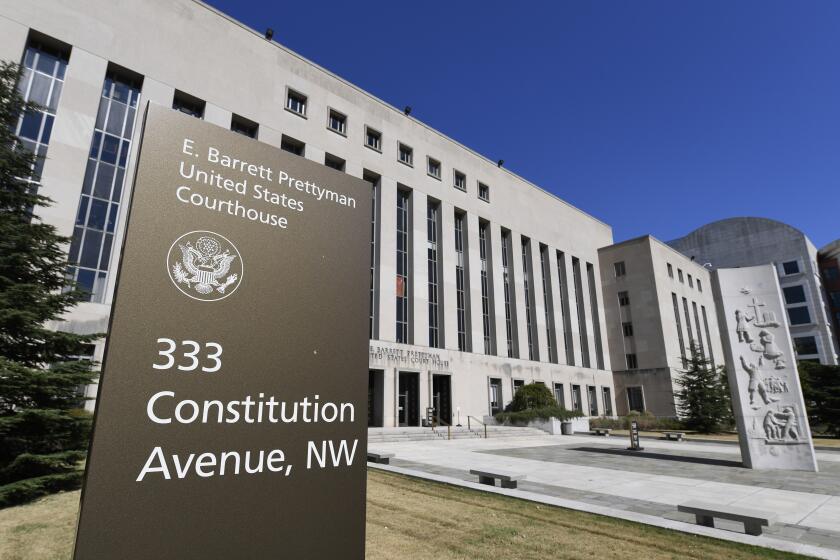‘Liberty: Mother of Exiles’ grandly pays tribute to the symbolic statue and immigrants
- Share via
The fine HBO-produced documentary “Liberty: Mother of Exiles” serves as a comprehensive primer on all things Statue of Liberty. The film is also a vital reminder of the longtime value and significance of immigration and freedom, for which the iconic statue, which attracts 4 million visitors a year, has been perhaps the ultimate symbol.
Award-winning directors Fenton Bailey and Randy Barbato, who have collaborated on a wealth of well-regarded feature and TV docs (“The Eyes of Tammy Faye,” “Carrie Fisher: Wishful Drinking,” “Becoming Chaz,” to name a few) largely structure their portrait around renowned fashion designer Diane von Furstenberg’s efforts to raise money for and oversee the building of a Statue of Liberty museum on New York’s Liberty Island.
Von Furstenberg, who’s been dubbed the statue’s “godmother,” helps the filmmakers explore their subject as she observes the museum’s development, discusses her own immigrant roots as the daughter of a Holocaust survivor (Von Furstenberg came to America from Belgium in 1970), and hops the globe to learn more about the statue’s creators and history.
She’s an ebullient and committed force (“People project their dream on Lady Liberty!”) though there is some thematic dissonance as she visits the dusty museum construction site maybe a bit too stylishly dressed and is driven around in a Bentley. On the other hand, it’s proof positive that, yes, immigrants can — and do — make it big time in America.
We meet up in Paris with the descendants of academic, author and anti-slavery activist Édouard de Laboulaye, who, in the 1860s, inspired sculptor Frédéric Auguste Bartholdi to build a monument that France could gift the United States to strengthen their relationship. After many incarnations, Bartholdi’s masterwork became what would eventually be known as the Statue of Liberty (a.k.a. the “Mother of Exiles”); the film neatly tracks its bumpy creative and financial trajectory.
Von Furstenberg and company take a jaunt to Colmar, France, for a ceremony at the lovely Musée Bartholdi, located in the home where the artist was born. Museum director Isabelle Bräutigam proves a warm guide (and she wears a Von Furstenberg-designed wrap dress, so there’s that.)
We’re also introduced to the ancestors of Gustave Eiffel (of Eiffel Tower fame) who designed Lady Liberty’s complex metal framework. Later, we get a tour inside the statue to witness Eiffel’s enduring scaffolding work. (Related factoids: The statue is said to be only “two pennies thick” and was built to move in the wind, which came in handy, as the movie recounts, during 2012’s Hurricane Sandy.)
As interesting and informative as this all is (there’s also strong supporting archival footage and photos), the film hits a deeper level of engagement when it focuses on the average folks whose lives have intersected with the statue, including locals who’ve lived and worked on Liberty Island. (Its last remaining residents — park superintendent David Luchsinger and his family — left after Sandy flooded them out).
Also represented here: recent young immigrants on a class trip to Lady Liberty, the construction guys building the new museum (it opened May 16) plus another who was notably involved in the statue’s mid-1980s restoration, factory workers in China and Long Island City who churn out Statue of Liberty souvenirs, a Russian graffiti artist whose output often features the statue, and several activists who’ve used the monument in high-profile ways to protest recently toughened immigration policies.
Their appearances all effectively underscore how, first and foremost, the Statue of Liberty exists for “the people.” Or at least that’s always been the intention.
As for politics, until the film’s final stretch, Bailey and Barbato don’t overly focus on the Trump administration and its harsh stance on dealing with refugees, one that negates the welcoming words of Emma Lazarus’ legendary, Lady Liberty-inscribed sonnet, “The New Colossus.”
In addition to shots of said protestors, the filmmakers pointedly include the says-it-all clip of White House senior policy adviser Stephen Miller’s misleading claim to CNN’s Jim Acosta that Lazarus’ poem was an afterthought to the Statue of Liberty, said as if to somehow undermine the meaning of the monument, “Colossus” and America’s commitment to immigration. (The facts: Lazarus’ 1883 poem, which, in part, expressed empathy for eastern European refugees, was written to raise money for the statue’s pedestal. It was not affixed to Miss Liberty until 1903, 17 years after the statue was unveiled.)
Although it occasionally plays as a Statue of Liberty promotional tool (there are worse things), the film is a timely, engaging and well-assembled look at one of our national treasures and its eternal place as a beacon of light for anyone “yearning to breathe free.”
'Liberty: Mother of Exiles'
In English and French with English subtitles
Not rated
Running time: 1 hour, 22 minutes
Playing: Starts Friday, Laemmle Music Hall, Beverly Hills; available Oct. 17 on HBO
More to Read
Only good movies
Get the Indie Focus newsletter, Mark Olsen's weekly guide to the world of cinema.
You may occasionally receive promotional content from the Los Angeles Times.






